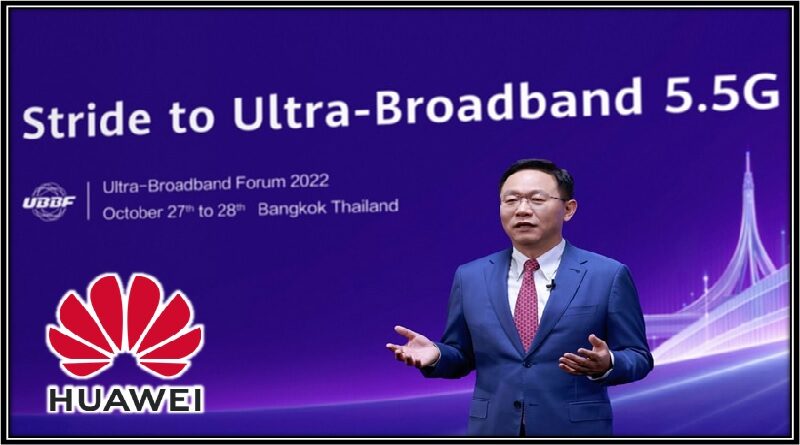Huawei: “Towards 5.5G is the Foundation of the Future”, David Wang
David Wang, Executive Director and Chairman of the Huawei ICT Infrastructure Governing Board, gave a keynote address at the 2022 Global Mobile Broadband Forum entitled “5.5G is the basis of the future.” David Wang emphasised that the industry has advanced significantly via teamwork and is prepared to switch to the 5.5G standard. He urged all industry participants to get ready on all fronts to hasten the shift to the 5.5G era and jointly create a better smarter society in order to realise this aim.
As the intellectual world swiftly approaches, we can expect dramatic changes. They’ll be connected to increased pressure on the internet infrastructure. The 5.5G standard is the next benchmark that needs to be achieved in order to transition to a smarter world. It will enable 10 Gbps data transport, support hundreds of billions of connections, and aid AI in becoming intelligent enough to compete with humans.
Mr. Wang emphasised that after two years of coordinated industry efforts, 5.5G has advanced significantly and three things have become obvious.
First off, 5.5G is already being standardised and is progressing quickly, so it is no longer simply an idea.
Second, the industry has made significant strides in the creation of essential 5.5G technologies, and ELAA and ultra-wide bandwidth can currently deliver 10 Gbps.
Third, the market has a distinct understanding of the Internet of Things (IoT) landscape. The NB-IoT, RedCap, and passive IoT technologies are three 5.5G-enabled IoT technology types that are evolving quickly and will support many connections in the IoT future.
“The communications industry is constantly evolving. The 5.5G standard is gaining momentum. Looking forward, our challenge is to explore these five new areas: standards, frequency band, products, ecosystems and applications. Let’s move towards the 5.5G standard together and build a better, smarter world,” David Wang , Executive Director and Chairman of the ICT Infrastructure Governing Board of Huawei
First, we need to set standards and support key technology research.
Standards direct the growth of the mobile communications sector and will chart a clear course for the development of 5.5G communications. The 18th version of the 3GPP standard, which will enable 5.5G networks to deliver 10 times greater performance, needs to be delivered by Q1 2024 as scheduled. We must collectively define what capabilities will be required for the 5.5G standard to support new services and situations as they emerge for version 19 and later. This will increase the utility of 5.5G and lengthen its useful life.
Secondly, we need to increase the frequency grid for ultra-wide bandwidth.
To construct ultra-wideband, we must utilise the resources below 100 GHz to their fullest extent. The main frequency band for the 5.5G standard is mmWave. To accomplish 10 Gb/s data transfer, operators will need to get more than 800 MHz of bandwidth in this frequency. Another potential ultra-wide band for the 5.5G standard is 6 GHz. The 6 GHz frequency will probably need to be placed up for auction when it is declared an IMT band at the World Radiocommunication Conference 2023 (WRC-23). In order to provide ultra-wide bandwidth for 5.5G communications, the sub-6GHz band can also be reconfigured.
Thirdly, we must prepare networks, devices and chips for the transition to the 5.5G standard.
We must update our networks and hardware in order to deliver data at 10 Gbps. Our solutions will specifically rely on ELAA technologies that can handle more than 1,000 antenna systems appropriate for the medium and high frequency bands, and support for 128T smart grids will necessitate the use of multiple antenna transmission (MIMO) technology. Additionally, 5.5G processors and devices will need to undergo further advancements in order to become smarter, capable of supporting 3T8R or even more channels, and able to connect more than four operators.
Fourth, we need to work together to create a growing 5.5G ecosystem.
In all circumstances, this expanding ecosystem will better meet digital needs. IoT ecosystem for 5.5G is one illustration. To improve the interaction between people and things, operators and equipment vendors will need to improve their 5.5G networking plans, and device vendors will need to customise pricing and modularity to application situations. The sector and application developers will also need to start creating new applications right once.
Fifth, it is necessary to continue working on innovative applications.
5.5G will become a reality and open up many more uses as our standards, variety, products, and ecosystem develop. Interactions involving several senses will alter how we communicate. Intelligent connections across industries will break down information silos and encourage industrial upgrading, and intelligently connected vehicles will establish themselves as the third mobile space and become widely used. Our understanding of the intelligent world is getting more and more clear as a new generation of creative applications emerges today. The research and development of these applications must be done collaboratively by all stakeholders in the industry.
Together with its business partners GSMA and GTI, Huawei is hosting the 2022 Global Mobile Broadband Forum. Every year, mobile operators, business executives, and ecosystem partners from across the world come together to discuss how to make 5G a commercial success as well as other important issues facing the industry, such as green development, artificial intelligence, and the advancement of 5G.
For More IT News Click Here




